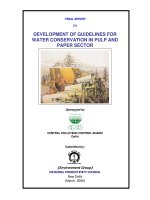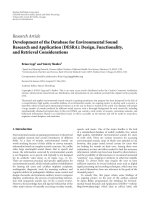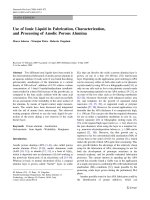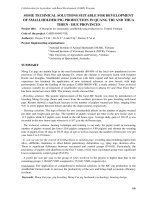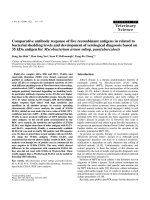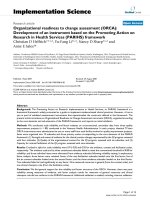Development of ionic liquid based liquid phase microextraction, and zeolite imidazolate frameworks based sorbent phase based microextraction combined with chromatography for applications in environmental analysis
Bạn đang xem bản rút gọn của tài liệu. Xem và tải ngay bản đầy đủ của tài liệu tại đây (1.93 MB, 156 trang )
DEVELOPMENT OF IONIC LIQUID BASED LIQUID
PHASE MICROEXTRACTION, AND ZEOLITE
IMIDAZOLATE FRAMEWORKS BASED SORBENT
PHASE BASED MICROEXTRACTION COMBINED WITH
CHROMATOGRAPHY FOR APPLICATIONS IN
ENVIRONMENTAL ANALYSIS
GE DANDAN
NATIOANAL UNIVERSITY OF SINGAPORE
2012
DEVELOPMENT OF IONIC LIQUID BASED LIQUID
PHASE MICROEXTRACTION, AND ZEOLITE
IMIDAZOLATE FRAMEWORKS BASED SORBENT
PHASE BASED MICROEXTRACTION COMBINED WITH
CHROMATOGRAPHY FOR APPLICATIONS IN
ENVIRONMENTAL ANALYSIS
by
GE DANDAN
(M.Sc., NATIONAL UNIVERSITY OF SINGAPORE)
A THESIS SUBMITTED FOR THE DEGREE OF PHILOSOPHY
DEPARTMENT OF CHEMISTRY
NATIOANAL UNIVERSITY OF SINGAPORE
2012
i
Thesis Declaration
The work in this thesis is the original work of Ge Dandan, performed independently
under the supervision of Professor Lee Hian Kee, (in the laboratory of Microscale
Analytical Chemistry), Chemistry Department, National University of Singapore,
between 03/08/2008 and 03/08/2012.
The content of the thesis has been partly published in:
1) D. Ge, H.K. Lee, Water stability of zeolite imidazolate framework 8 and
application to porous membrane-protected micro-solid-phase extraction of
polycyclic aromatic hydrocarbons from environmental water samples, J.
Chromatogr. A 1218 (2011) 8490.
2) D. Ge, H.K. Lee, Ionic liquid based hollow fiber supported liquid phase
microextraction of ultraviolet filters, J. Chromatogr. A 1229 (2012) 1.
3) D. Ge, H.K. Lee, A new 1-hexyl-3-methylimidazolium
tris(pentafluoroethyl)trifluorophosphate ionic liquid based ultrasound-assisted
emulsification microextraction for the determination of organic ultraviolet filters
in environmental water samples, J. Chromatogr. A 1251 (2012) 27.
4) D. Ge, H.K. Lee, Zeolite imidazolate frameworks8 as sorbent and its application to
sonication-assisted emulsification microextraction combined with vortex-assisted
porous membrane-protected micro-solid-phase extraction for fast analysis of acidic
drugs in environmental water samples, J. Chromatogr. A 1263 (2012) 1.
Name
Signature
Date
ii
Acknowledgements
Foremost, I would like to express my sincere gratitude to my supervisor, Professor Lee
Hian Kee, for his invaluable suggestions, guidance and encouragement throughout this
study. Under his guidance, I gained precious research experience and learnt how to carry
out research work independently.
I am grateful to my colleagues, Lee Jingyi, Zhang Hong, Lim Tze Han, Zhang Yufeng,
Seyed Mohammad Majedi, Xu Ruyi, Nyi Nyi Naing and Huang Zhenzhen who gave me
their help and advice during my candidature.
I would also thankful to Mdm Lim Guek Choo, Dr Liu Qiping and many other laboratory
officers in the Department of Chemistry for their kind help and assistance. I appreciate
the National University of Singapore for providing me the financial support during the
period of this research.
Finally, I would like to appreciate my family for their endless love, support and
encouragement. Appreciation is also addressed to my friends. Without their support, my
research could not have gone ahead successfully.
iii
Table of Contents
Thesis Declaration.……………………………………………………………………… і
Acknowledgement……………………………………………………………………… ii
Table of Contents…………………………………………………………………………iii
Summary………………………………………………………………………………….ix
List of Tables……………………………………………………………………………xiii
List of Figures………………………………………………………………………… xv
List of Abbreviations………………………………………………………………… xvii
Section 1 Introduction………………………………………………………………… 1
Chapter 1. Introduction………………………………………………………………3
1.1 Sample preparation…………………………………………………………… 3
1.2 Liquid phase microextraction (LPME)…………………………………………4
1.2.1 Single drop microextraction (SDME)…………………………………… 5
1.2.1.1 Direct immersion SDME (DI-SDME)……………………………… 5
1.2.1.2 Headspace SDME (HS-SDME)………………………………………7
1.2.1.3 Continuous flow microextraction (CFME)………………………… 7
1.2.2 Hollow fiber-protected LPME (HF-LPME)………………………………8
1.2.2.1 Two-phase HF-LPME……………………………………………… 9
1.2.2.2 Three-phase HF-LPME…………………………………………… 10
1.2.2.3 Solvent-bar microextraction…………………………………… ….11
1.2.3 Dispersive liquid-liquid microextraction…………………………………11
1.2.4 Ionic liquid based LPME…………………………………………………12
1.3 Sorbent phase-based microextraction (SPBME)………………………………14
iv
1.3.1 Solid phase microextraction (SPME)…………………………………….14
1.3.2 In-tube SPME…………………………………………………………….15
1.3.3 Stir bar sorptive extraction (SBSE)………………………………………16
1.3.4 Microextraction in a packed syringe (MEPS)……………………………16
1.3.5 Micro solid-phase-extraction (μ-SPE)……………………………………17
1.3.5.1 μ-SPE……………………………………………………………… 17
1.3.5.2 Materials applicable to μ-SPE………………………………………18
1.3.5.2-1 Silica-based sorbent………………………………………… 18
1.3.5.2-2 Hybrid materials……………………………………………….18
1.3.5.2-3 Carbonaceous materials……………………………………….19
1.4 Objective and scope of the study………………………………………………21
Section 2 Ionic Liquid-based Liquid Phase Microextraction……………………… 25
Chapter 2. Ionic liquid based liquid phase microextraction of UV filters………….31
2.1 Introduction………………………………………………………………… 31
2.2 Experimental………………………………………………………………….34
2.2.1 Materials and chemicals…………………………………………………34
2.2.2 Instrumentation………………………………………………………… 35
2.2.3 Extraction procedure…………………………………………………… 36
2.2.3.1 IL-HF-LPME………………………………………………………36
2.2.3.2 USAEME……………………………………………………… 36
2.2.4 Blank Contamination…………………………………………………… 37
2.2.5 Optimization strategy for USAEME.…………………………………… 37
2.3 Results and discussion…………………………………………………………38
v
2.3.1 IL-HF-LPME of UV filters…………………………………………….…38
2.3.1.1 Effect of IL solvents………… ………………….…………………39
2.3.1.2 Effect of different pH of the aqueous phase……….…… …………40
2.3.1.3 Effect of stirring rate………… …… ………….…………………40
2.3.1.4 Effect of extraction time………….…………………………………41
2.3.1.5 Effect of salt concentration……… …………… …………………42
2.3.1.6 Method validation and application…………………………………43
2.3.2 USAEME of UV filters…………………………………………….…… 45
2.3.2.1 Initial experiment……………………………………………………45
2.3.2.2 Further optimization……………………………………………… 48
2.3.2.3 Evaluation of method performance…………………………………51
2.3.2.4 Analysis of environmental samples…………………………………52
2.4 Conclusion remarks……………………………………………………………53
Section 3 Zeolite Imidazolate Frameworks based Micro-solid-phase
Extraction……………………………………………………………………………….55
Chapter 3. Water stability of zeolitc imidazolate framework 8 and application to porous
membrane-protected micro-solid-phase extraction of polycyclic aromatic
hydrocarbons from environmental water samples……………………………………61
3.1 Introduction……………………………………………………………………61
3.2 Experimental………………………………………………………………… 62
3.2.1 Chemicals and materials…………………………………………………62
3.2.2 Instrumentation………………………………………………………… 63
3.2.3 Synthesis of ZIF-8……………………………………………………… 63
vi
3.2.4 Preparation of µ-SPE Device……………………………………………65
3.2.5 Sample preparation………………………………………………………65
3.2.6 Extraction Procedures……………………………………………………65
3.3 Results and discussion…………………………………………………………66
3.3.1 Characterization of ZIF-8……………………………………………… 66
3.3.2 Extraction optimization………………………………………………… 68
3.3.2.1 Sorbent materials……………………………………………………68
3.3.2.2 Desorption solvent………………………………………………… 69
3.3.2.3 Desorption time…………………………………………………… 70
3.3.2.4 Extraction time………………………………………………………71
3.3.2.5 Salt concentration………………………………………………… 72
3.3.3 Method evaluation……………………………………………………… 73
3.3.4 Analysis of environmental water samples……………………………… 74
3.4 Conclusion remarks……………………………………………………………75
Chapter 4. Zeolitic imidazolate frameworks-8 as sorbent and its application to
sonication-assisted emulsification microextraction combined with vortex-assisted
porous membrane-protected micro-solid-phase extraction for fast analysis of acidic
drugs in environmental water ……………………………………………………… 77
4.1 Introduction……………………………………………………………………77
4.2 Experimental………………………………………………………………… 78
4.2.1 Chemicals and materials…………………………………………………78
4.2.2 GC-MS analysis………………………………………………………….79
4.2.3 Characterization of ZIF-8……………………………………………….80
vii
4.2.4 Extraction procedures……………………………………………………80
4.2.4.1 SAE-VA-μ-SPE …………………………………………………… 80
4.2.4.2 Agitation-assisted µ-SPE (AA-µ-SPE) and sonication-assisted
combined with vortex-assisted µ-SPE (SA-VA-µ-SPE)…………………… 81
4.3 Results and discussion…………………………………………………………81
4.3.1 Characterization of ZIF-8……………………………………………… 81
4.3.2 Optimization of the SAE-VA-μ-SPE of acidic drugs …………………….83
4.3.2.1 Comparison of SAE-VA-μ-SPE with AA-µ-SPE and SA-VA-µ-SPE 83
4.3.2.2 Selection of desorption solvent ………………………………………84
4.3.2.3 Volume of extraction solvent……………………………………… 85
4.3.2.4 Emulsification time………………………………………………….86
4.3.2.5 Desorption time………………………………………………… 86
4.3.2.6 Salt effect……………………………………………………………87
4.3.2.7 Adjustment of pH……………………………………………………88
4.3.3 Method evaluation……………………………………………………… 89
4.3.4 Genuine water analysis………………………………………………… 90
4.4 Conclusion remarks……………………………………………………………91
Chapter 5. Ionic liquid based dispersive liquid-liquid microextraction coupled with
micro-solid phase-extraction of tricyclic antidepressants drugs from environmental
water samples ……………………………………………………………………… 93
5.1 Introduction……………………………………………………………………93
5.2 Experimental………………………………………………………………… 95
5.2.1 Reagents and chemicals………………………………………………….95
viii
5.2.2 Synthesis of ZIF-4……………………………………………………… 95
5.2.3 Apparatus…………………………………………………………………95
5.2.4 Extraction procedures…………………………………………………….96
5.2.4.1 IL-DLLME-VA-μ-SPE……………………………………………….96
5.2.4.2 Direct µ-SPE (D-µ-SPE)……………………………………………98
5.3 Results and discussion…………………………………………………………98
5.3.1 Optimization of IL-DLLME-VA-μ-SPE process………………………….98
5.3.1.1 Comparison of IL-DLLME-VA-μ-SPE with SA-VA-µ-SPE…………98
5.3.1.2 Effect of extraction solvent………………………………………….99
5.3.1.3 Effect of the volume of extractant………………………………….100
5.3.1.4 Effect of sonication time………………………………………… 101
5.3.1.5. Effect of desorption solvent……………………………………….102
5.3.1.6 Effect of pH of aqueous phase………………………………… …103
5.3.1.7 Effect of desorption time…………………………………… ……104
5.3.1.8 Effect of salt concentration……………………………… 105
5.3.2 Method evaluation………………………………………………………106
5.3.3 Analysis of genuine water samples…………………………………… 107
5.4 Conclusion remarks………………………………………………………… 107
Section 4 Conclusions and future work…………………………………………… 109
Chapter 6. Conclusions and future work……………………………………………111
References…………………………………………………………………………… 117
List of Publications……………………………………………………………………133
ix
Summary
Sample preparation techniques are received increasing attention in the past few decades
since they are critical in an analytical procedure. Along with the trend in miniaturization
in analytical chemistry, microextraction methods have undergone rapid development.
This thesis reports the development and application of ionic liquids (ILs) for liquid phase
microextraction (LPME) and zeolite imidazolate frameworks (ZIFs) for sorbent phase-
based microextraction (SPBME). An introduction to sample preparation and LPME and
SPBME is given in Section 1.
In Section 2, a new type of IL, 1-hexyl-3-methylimidazolium
tris(pentafluoroethyl)trifluorophosphate ([HMIM][FAP]) applied in two-phase hollow
fiber based LPME (HF-LPME) and ultrasound-assisted emulsification microextraction
(USAEME) combined with high-performance liquid chromatography-ultraviolet (HPLC-
UV) for the analysis of UV filters is reported.
In Chapter 2 of Section 2, HF-LPME using an IL as supported phase and acceptor phase
(IL-HF-LPME) is proposed for the determination of four ultraviolet (UV) filters
(benzophenone, 3-(4-methylbenzylidene)-camphor, 2-hydroxy-4-methoxybenzophenone
and 2,4-dihydroxybenzophenone) in water samples for the first time. In this study, four
different ILs 1-hexyl-3-methylimidazolium tris(pentafluoroethyl)trifluorophosphate)
[HMIM][FAP], 1-butyl-1-methylpyrrolidinium tris(pentafluoroethyl)trifluorophosphate
[BMPL][FAP], 1-butyl-3-methylimidazolium phosphate ([BMIM][PO
4
]) and 1-butyl-3-
x
methylimidazolium hexafluorophosphate ([BMIM][PF
6
]) were evaluated as extraction
solvent. Only [HMIM][FAP] showed high chemical affinity to the analytes which permits
a selective isolation of the UV filters from the sample matrix, allowing also their
preconcentration. IL-HF-LPME and high performance liquid chromatography (HPLC)
provides repeatability from 2.4 and 7.5% and limits of detection (LODs) between 0.3 and
0.5 ng/ml.
In Chapter 2, another approach termed IL based USAEME (IL-USAEME) combined
with HPLC-UV was developed for the preconcentration and detection of UV filters in
environmental water samples. An IL was used in place of an organic solvent as in
conventional USAEME. In the study, orthogonal array designs (OAD) were employed for
the optimization of the extraction parameters: type of IL, pH of the sample, extraction
volume, ultrasonic time and salt concentration. In the first step, a mixed level OAD
matrix, OA
16
(4
1
×2
12
) was employed for the initial optimization. Based on the results of
the first step, an ultra-hydrophobic IL, [HMIM][FAP] was chosen as the IL extractant.
Ultrasonic time, extraction volume and salt concentration was further optimized in the
second step by an OA
16
(4
5
) matrix. Under the latter optimized conditions, the LODs for
four UV filters were between 0.5 and 1 ng/ml. The validated technique was applied to the
analysis of UV filters in environmental water samples.
In Section 3, the thesis reports on a subclass of metal organic frameworks (MOFs),
zeolite imidazolate frameworks (ZIFs) used as extraction sorbent of micro-solid-phase
extraction (µ-SPE). ZIFs have permanent porosity, high surface area, hydrophobic
xi
property, open metal sites and remarkable water stability. These novel properties
characterize these materials as being different from other moisture sensitive MOFs and
endow ZIFs with the potential to extract trace analytes from environmental water samples.
In Chapter 3, the synthesis of ZIF-8 used as a sorbent for micro-solid-phase extraction (µ-
SPE) of 6 polycyclic aromatic hydrocarbons (PAHs) from environmental water samples
is reported. Parameters influencing the extraction efficiency such as desorption time,
extraction time, desorption solvent and salt concentration were investigated. ZIF-8 was
demonstrated to be a very efficient extraction sorbent for the extraction of trace analytes
from environmental water samples. The LODs from gas chromatography-mass
spectrometry (GC-MS) analysis of PAHs were 0.002 to 0.012 ng/ml.
In Chapter 4, a new microextraction method, sonication-assisted emulsification combined
with vortex-assisted µ-SPE (SAE-VA -µ-SPE), is introduced for the determination of
acidic drugs. The required extraction time for this extraction method was less than 10 min,
which showed that SAE-VA -µ-SPE was a very effective way to reduce extraction time.
Specialized apparatus, such as a conical-bottom test tube or a centrifuge, and tedious
procedures associated with classical dispersive liquid-liquid microextraction (DLLME)
such as centrifugation, or refrigeration of the extraction solvent are not required. The
LODs ranged between 0.01 and 0.03 ng/ml.
In Chapter 5, IL-DLLME which involves a substantial usage of organic solvent,
combined with μ-SPE (IL-DLLME-μ-SPE), and HPLC was developed for the
xii
determination of tricyclic antidepressants (TCAs) in water samples. A characteristic
property of DLLME-VA -μ-SPE is that any organic solvent immiscible with water and
solid sorbent can be used. A novel material, ZIF-4 was employed as μ-SPE sorbent. The
LODs were in the range of 0.3 and 1 μg/l. The results showed that IL-DLLME-μ-SPE
was suitable for the determination of TCAs in water samples.
xiii
List of Tables
Table 2-1 Structures and some relevant physico-chemical properties of analytes
Table 2-2 Quantitative results of IL-HF-LPME
Table 2-3 Relative recoveries and precision of IL-HF-LPME of tap water spiked with UV
filters at different concentration
Table 2-4 Assignment of factors and level settings of the experiment runs in the OA
16
(4
1
×2
12
) matrix
Table 2-5 OA
16
(4
1
× 2
12
) matrix along with experimental results
Table 2-6 Assignment of factors and level settings of the experiment runs in the OA
16
(4
5
)
matrix
Table 2-7 OA
16
(4
5
) matrix along with experimental results
Table 2-8 An ANOVA table for experimental responses in the OA
16
(4
5
) matrix
Table 2-9 Quantitative results of IL-USAEME
Table 2-10 Relative recoveries and precision of IL-USAEME of river water and tap water spiked
with UV filters at different concentration (10 ng/ml and 100 ng/ml)
Table 3-1 Structures and relevant physico-chemical properties of analytes
Table 3-2 Elemental analysis results of ZIF-8
Table 3-3 Comparison of positions in the experimental and simulated XRD patterns from
its single crystal structure of ZIF-8
Table 3-4 Linear range, regression data, LODs, LOQs of PAHs
Table 3-5 Analytical Results for the determination of PAHs in real samples
Table 4-1 Structures and some relevant physico-chemical properties of analytes
Table 4-2 Linear range, regression data, and LODs of acidic drugs
